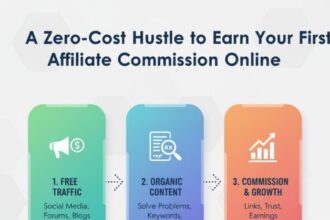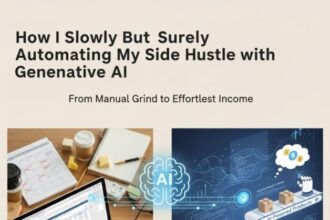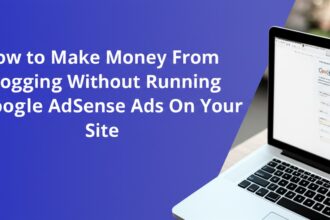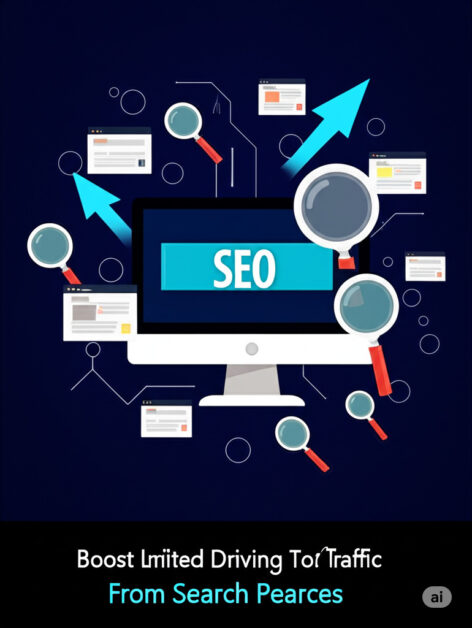I Tried to Make Money from My Blog. Here’s My Messy, Honest Showdown of Google AdSense vs. Affiliate Marketing.
The email notification was so exciting it felt like a tiny electric shock.
“Congratulations! Your site is now ready to show ads.”
I had done it. I had been approved for Google AdSense. I felt like I had just been accepted into an exclusive club. I was a “publisher.” A real, live, professional blogger who was about to start making money.
I immediately plastered my little gardening blog with ads. I put them in the header, the sidebar, in the middle of my posts. My website looked like a race car driver’s jacket. But I didn’t care. I was about to get rich.
A month later, I checked my first official earnings report. My grand total? Seventeen dollars and twenty-one cents.
My heart just… sank. I had spent countless hours on my blog. All that work, all that passion, for less than the price of a large pizza.
That night, my defeated Google search was a question that had been nagging at me for weeks. What was I doing wrong? Was there a better way? This led me down the deep, dark rabbit hole of Google AdSense vs. affiliate marketing.
This isn’t a guide from a seven-figure blogging guru. I’m just a regular person who was tired of making pizza money. This is the real, messy, and often confusing story of my journey to figure out how to actually earn a real income from the thing I love to do.
My First Clumsy Steps into the World of Making Money Online
My initial foray into the world of blog monetization was a masterclass in what not to do.
I was completely clueless. I just assumed that if you had a blog, you put AdSense on it, and then money would magically appear in your bank account.
I had no strategy. I had no plan. I just had a vague, hopeful dream of passive income for bloggers.
Drowning in a Sea of Acronyms
My first attempt was to try and understand AdSense better. I figured if I could just “optimize” my ads, I could make more money.
This led me straight into a wall of jargon. RPM. CPC. CTR. It was like trying to learn a new language, but a really boring one that was all about math. I spent hours reading Google’s own documentation, like this “beginner’s guide to AdSense terms”, and my head was just spinning.
I became obsessed with my AdSense RPM rates, which stands for “Revenue Per Mille,” or what you earn for every thousand pageviews. It felt like if I could just nudge that number up, all my problems would be solved. I tried different ad placements. I tried different ad sizes. The number barely budged.
I was spending all my energy trying to rearrange the deck chairs on the Titanic, not realizing the ship was sailing in the wrong direction. I was so focused on the how of making money with ads that I never stopped to ask why it wasn’t working.
My “Brilliant,” Spammy Foray into Affiliate Marketing
After my AdSense disappointment, I discovered affiliate marketing. This seemed like the real secret.
The concept was simple: you recommend a product, and if someone clicks your special link and buys it, you get a commission. It seemed so much more direct. So, I signed up for Amazon Associates, the biggest beginner’s guide to affiliate marketing program out there.
And I went completely insane. I went back through all my old blog posts and just started cramming affiliate links in everywhere. An article about tomatoes? Here are ten links to different kinds of gardening gloves! A post about roses? Here are five different kinds of fertilizer!
My posts started to look like spammy catalogues. The links were clunky. They were unnatural. I wasn’t genuinely recommending these things; I was just hoping someone, anyone, would click on them.
The result? I made a grand total of zero sales. And I probably annoyed the few loyal readers I actually had. I was treating my audience like a walking wallet, and they could tell.
It Turns Out, Most “Blog Monetization” Advice is a Trap
After failing spectacularly at both AdSense and affiliate marketing, I was ready to give up. I started to believe that making real money from a blog was a myth, a lie sold to you by the people selling courses on how to make money from a blog.
I started to see the industry for what it is: a world full of myths and bad advice that can lead well-intentioned creators down a frustrating path.
The Big Myth: “AdSense is Purely Passive Income.”
This is the siren song of AdSense. Just set it up, forget about it, and watch the pennies roll in.
And yes, compared to a 9-to-5 job, it is “passive.” You don’t have to actively be sitting at your computer to earn a nickel.
But it’s not truly passive. To make any significant money from AdSense, you need a huge amount of traffic. And getting a huge amount of traffic is one of the most active, difficult, and time-consuming things you can do.
You have to be constantly creating new, high-quality content. You have to be doing SEO. You have to be promoting your work. It’s a relentless content treadmill.
The ad revenue might be passive, but the work required to get it is anything but.
The Sneaky Lie: “Affiliate Marketing is Just Selling Out.”
I used to feel this way. I thought putting affiliate links on my blog was somehow “icky.” That I was compromising my integrity. That I was turning my passion project into a sleazy sales pitch.
And if you do it the way I did it at first—just spamming random links everywhere—then yes, it is selling out.
But then I started to look at my favorite websites. Sites like Wirecutter, the product review site from The New York Times. Their entire business model is affiliate marketing. But I don’t feel like they’re selling out. I trust them. Why? Because they do an insane amount of work to test and research the products they recommend. Their “How We Test” page (here) is a masterclass in building trust.
I realized that affiliate marketing is only icky if you make it icky. If you genuinely love a product and believe it will help your audience, then recommending it isn’t selling out. It’s being helpful.
The Dangerous Myth: “You Have to Choose One or the Other.”
This was the mental box I had put myself in. I thought it had to be a big showdown: Google AdSense vs. affiliate marketing. That I had to pick a side.
You see this all the time in forums. People will argue passionately that AdSense is for suckers and the real money is in affiliate marketing. Others will argue that affiliate marketing is too much work and AdSense is the only truly scalable model.
But why does it have to be a choice? Why can’t it be both? They are not mutually exclusive. They are just two different tools in your monetization toolbox. You can have a hammer and a screwdriver. You can use them for different jobs.
Thinking I had to choose one kept me stuck. It made me feel like I had to make one perfect, irreversible decision. It was a false choice that was preventing me from making any progress at all.
The Simple, Obvious Idea That Changed Everything
I was so focused on the monetization method. I was obsessing over the tools. AdSense. Affiliate links.
I was trying to figure out the best way to extract money from my blog. The breakthrough for me came when I stopped trying to extract money from my blog, and I started trying to create value for my reader.
The core idea that changed everything was this: You don’t have a monetization problem. You have a trust problem.
My Flawed “Vending Machine” Mindset
For months, I was treating my blog like a vending machine.
My content was the machine itself. And AdSense and affiliate links were the little slots where I hoped people would put their money (or their attention, which is the currency of AdSense).
I was just sitting there, waiting for people to walk up, put in a coin, and get a snack. I was completely passive. I was providing a low-value transaction. And I was wondering why I was only making pennies.
A vending machine is not a business. It’s a convenience. And it’s easily ignored.
My New Mission: Become a “Trusted Friend”
My new approach was to stop being a vending machine and start being a trusted friend.
Think about it. When your best friend, who you know has great taste in books, tells you, “You absolutely have to read this new novel, it’s incredible,” what do you do? You probably go out and buy it. You don’t even have to think about it. You trust their recommendation implicitly.
Now, imagine a random stranger on the street shouting at you, “Buy this book!” You’d probably walk away as fast as you could.
For months, I was being the random stranger.
My new mission was to become that trusted friend for my readers. My goal was to build such a deep relationship with them, to provide so much consistent value, to be so honest and transparent, that when I finally did recommend something, they would listen. This is the heart of building trust with your audience. It’s a journey I explore in the post, “My Long, Painful Journey to Understanding My Audience.”
This meant a complete shift in my content strategy for monetization. The money was no longer the goal; it was the byproduct of the trust I had built.
My No-BS “How I Actually Make Money Now” Guide
So what does being a “trusted friend” actually look like in practice?
This isn’t a get-rich-quick scheme. This is a get-rich-slow, sustainable, and enjoyable plan. It’s the system that finally started bringing in a real income for me, and it’s a hybrid approach that uses the best of both worlds.
1. I Use AdSense as the “Floor.”
I still use Google AdSense. But I’ve changed how I think about it. It’s no longer my primary focus. It’s my “floor.” It’s the base level of income that the site generates just by existing and having traffic. I’ve become much more strategic about it. I have far fewer ads now, but they are in better-performing locations. AdSense is my safety net. It pays for my web hosting and my coffee. It’s not the dream, but it’s a solid, reliable foundation.2. I Only Recommend Products I Genuinely Love and Use.
This is my number one rule for affiliate marketing. I will never, ever recommend a product I haven’t personally used and fallen in love with. My audience can tell the difference. If I’m writing about my favorite gardening tools, it’s because I’ve spent years with dirt under my fingernails, using those exact tools. This is the secret to choosing the right affiliate products. It’s not about which ones have the highest commission; it’s about which ones you can talk about with genuine, unshakeable passion.3. I Write “Review” Posts, Not “Sales” Posts.
When I do recommend an affiliate product, I don’t write a sales page. I write an incredibly detailed, honest review. I talk about what I love about it. But I also talk about what I don’t love about it. I mention who it’s for, and who it’s not for. This honesty is crucial. It shows my readers that I’m not just trying to make a buck; I’m trying to help them make an informed decision. This is the essence of the topic, “Why ‘Authenticity’ is the Most Important Metric You’re Not Tracking.”4. I Am Obnoxiously Transparent.
Every single post that contains an affiliate link has a clear, easy-to-read disclosure at the very top. It says something like, “Just so you know, this post contains affiliate links. This means if you click and make a purchase, I may earn a small commission at no extra cost to you. I only recommend products I truly believe in.” This isn’t just a good idea; it’s the law. The FTC has very clear guidelines on this, which you can read about here. Being upfront about it doesn’t scare people away; it builds even more trust.5. I Create My Own Products.
This was the final piece of the puzzle for me. After years of building trust with my audience, I realized I could create my own products to solve their specific problems. I started with a simple ebook: “My Top 10 Mistakes as a Beginner Gardener.” It took me a weekend to write. I sold it for $10. The feeling of selling something I had created myself was a thousand times more satisfying than any affiliate commission. This is the ultimate form of monetization because you are in complete control.
This hybrid model—AdSense as the floor, affiliate marketing as the helpful recommendation, and my own products as the ultimate solution—is what finally worked for me.
So, Which Is More Profitable? AdSense or Affiliate Marketing?
The person who was staring at his pathetic $17.21 AdSense report? He still lives in my head sometimes. He reminds me of how far I’ve come.
So, after all this, what’s the answer? The big showdown. Google AdSense vs. affiliate marketing. Which one wins?
It’s the wrong question.
It’s like asking, “What’s a better tool, a hammer or a screwdriver?”
It’s a dumb question. You need both. They do different jobs.
AdSense is a hammer. It’s a blunt instrument. You need a lot of force (traffic) to build anything significant with it. But it’s reliable. It always works, even if it’s just putting in small nails.
Affiliate marketing is a screwdriver. It’s a precision tool. It works best on specific, targeted problems. You can build something much more intricate and valuable with it, but you have to know exactly where to apply the pressure. You have to have the trust of your reader.
For me, personally? Affiliate marketing and my own products are now far, far more profitable than AdSense. By a huge margin.
But I couldn’t have gotten here without AdSense. It was the tool that paid the bills while I was learning how to use the screwdriver.
So the secret isn’t to choose one. It’s to learn how to use both. It’s to build a business, not just a blog. And to do it from a place of service and trust, not from a place of desperation.
And that has been the most profitable lesson of all.
So, here’s my question for you. Are you trying to build a house with only a hammer? What’s the one “screwdriver” product you genuinely love that could help your audience?










































